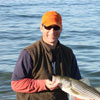How to catch fish by reading the water
By Tom Keer
Jun 24, 2015
One of the most important angling skills is learning how to catch fish by reading the water.
One of the most important angling skills is learning how to catch fish by reading the water. Finding the fish is paramount to catching them, and know this; fish are opportunistic, which means that they want to take in more calories than they burn up. If you can find 'em you can catch 'em, so look for them in some of these areas.

.jpg)
Streams and Rivers
Behind or above structure. Rocks or deadfall are great places to find fish in moving water as both divert the current. A boulder is a good example, and the fish will hold in the slower current above the bolder or behind it. Trout, bass and panfish can then dip into the faster current and pick off baitfish or insects drifting downstream. The same holds true with any trees that have fallen into the water.
Below feeder streams. River fish find insects washing down from feeder streams, but they also like the oxygen-rich water, too. The fish will hold in the slower water closer to the bank. They may be outside of the feeder stream particularly if heavy spring run off hollows out the stream bed.
Below islands. When a river splits and runs around an island the spot below the island is a good one to check out. The fish can hold in the slower water and pick food from two stems of the river.
Pools. A pool is a deeper area with slow moving water that is usually below shallower water. Look for fish at the head of the pool (top part), in the middle, or in the tail (the end). The head of the pool offers more oxygen and lots of food, the middle is usually deeper and provides cooler temperatures, and anything that gets washed down channels out through the tail. Faster currents at the head and the tail means that a fish has to make up its mind...and quickly.
Undercut Banks. River currents slow down when they run underneath a bank. The slower currents are nice, and the land protects the fish from birds of prey like ospreys or eagles.
In vegetation. Moss or water cress hold lots of insects and baitfish, so probe around the edges for fish cruising through.
Now that you know all about reading the water, go catch them! If you need to renew or get a fishing license, check our states page to find specific information of fishing license per state.









